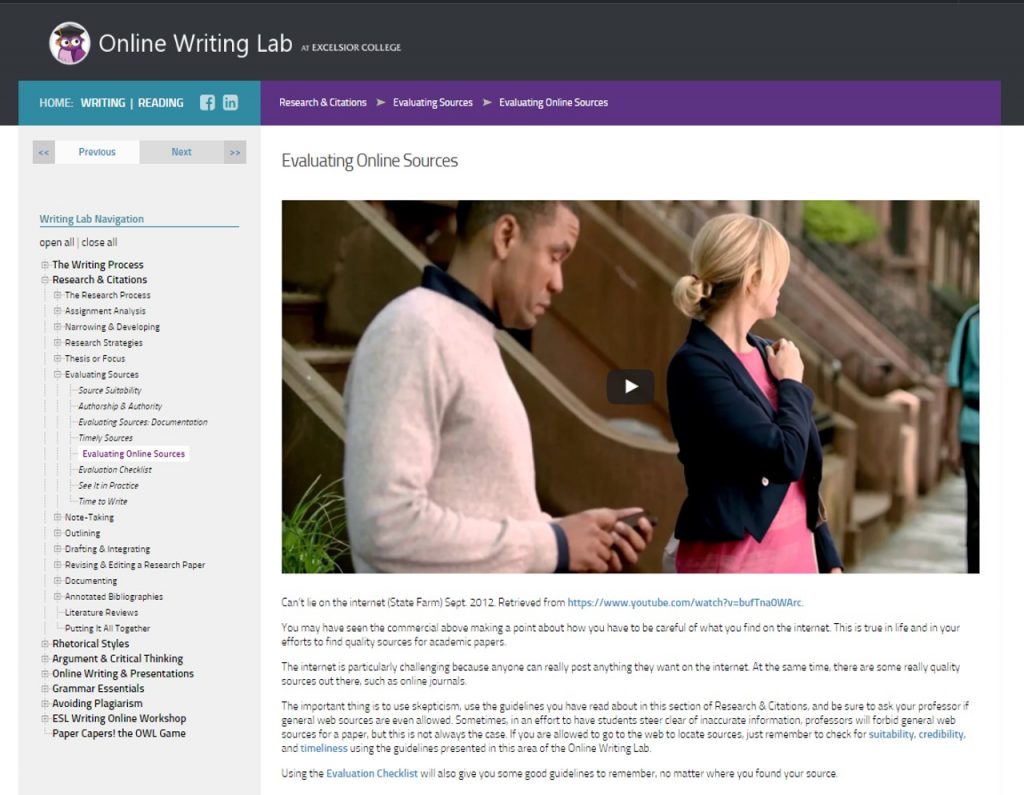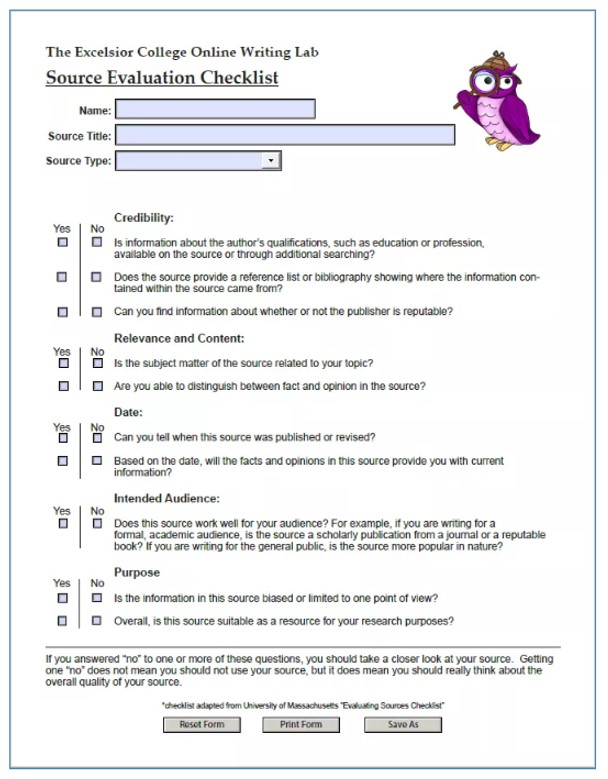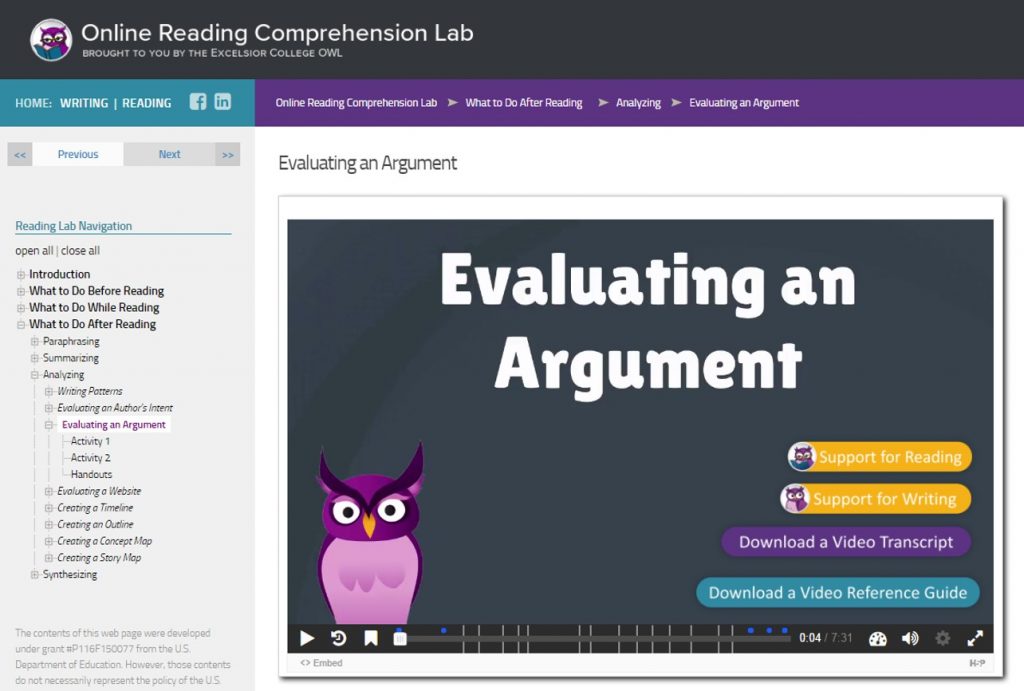Giving A Hoot About Being Duped
How To Use The OWL To Help Students Navigate Source Credibility
By Elizabeth Johnson, PhD
In 2015, Oxford Dictionaries awarded the term “post truth” as word of the year, defending their choice by arguing that “post-truth has gone from being a peripheral term to a mainstay in political commentary, now often being used by major publications without the need for clarification or definition in their headlines.” In November 2016, the Stanford History Education Group released their study of K-16 students’ abilities to evaluate information they read online. Their findings?: “Overall, young people’s ability to reason about the information on the Internet can be summed up in one word: bleak.” According to the study, students are “easily duped,” ill equipped to distinguish between real and fake news (p. 4). How can instructors help students navigate a world of fake news and post truth so they aren’t being duped?[i]
The OWL can be a useful resource for instructors seeking to help students evaluate and verify the credibility of resources, and in this blog post I’d like to suggest ways I’ve used it in my own class to this end.
The Owl On the Ground: Lesson 1

During the first lesson, we spend time discussing the problem of navigating source credibility. As a “hook” to engage their interest on the topic, I show them the “Evaluating Online Sources” video. This video, about someone being duped by a misleading online dating profile, usually gives students a giggle and leads into discussion about what’s at stake. I ask students to brainstorm what they’ve seen or heard about fake news and/or what their own experiences have been using sources. At the end of the class period, I have students freewrite about what they’ve learned during the discussion; I also ask them to write down the questions they still have about source credibility.[ii]
For “homework,” I instruct students to review the sections on Suitability, Authorship and Authority, Documentation, and Timeliness. I also point them to the Evaluation Checklist. Finally, I instruct them to view both the Online Reading Comprehension Lab’s (ORC) video on Evaluating a Website and the OWL’s “See it in Practice” video.

The Owl on the Ground: Lesson 2
We begin the second discussion by reviewing the four “checks” for source credibility. I ask my students to discuss what new information they’ve learned from their time spent reviewing the OWL. I then tell my students to imagine they are researching a particular topic for a traditional research paper whose audience will be other college students. Note: because we might not have first reviewed the OWL’s section on narrowing topics and because the second part of this exercise requires close reading, for this particular classroom exercise I provide the topic. I try to choose something current and controversial; last semester I used Trump’s Travel Ban. Using classroom technology, students follow along as I conduct a Google Search (on the overhead, on their own computers or smart devices, or if in an online classroom via a series of video tutorials I’ve created). Together we examine the “hits” we receive, clicking on each and conducting a collective, if cursory evaluation. Students are asked to refer to the Evaluation Checklist I’ve provided them as they determine whether each source merits further consideration. Fairly easily determined is Timeliness. Also fairly easily determined is whether an author is listed. However, questions about Source Suitability, Author’s Authority, and Credibility of Documentation will require deeper analysis.
The Owl on the Ground: Lesson 3 (Digging Deeper)
In this lesson we dig deeper into one of the sources from the previous lesson. We first navigate to and examine Source Suitability; we review again the criteria and students are asked to determine if the source qualifies as Overview Material, Focused Lay Materials, or Specialists Material. They determine if this is a suitable source for their purposes. Next, we navigate to Authorship and Authority. We together review the criteria: we look to see if there is Publisher Provided Biographical Information; if not or in addition to that material, we discuss how to find Outside Biographical Information. Next, we navigate to and review the criteria for Source Documentation; we then collectively discuss whether any red flags are raised by the documentation in the source I’ve given to them.
 We also assess the source for credibility related to bias. In my course, the module leading up to our research module focuses on Rhetorical Analysis, so my students will have used the OWL previously to work on identifying and analyzing Modes of Persuasion. They have also spent previous class periods discussing and identifying Logical Fallacies. Students can also refer to the very useful video in the ORC on Evaluating an Argument, which covers facts, opinions, and logical fallacies, too. Now I put my students into small groups and have them identify and evaluate elements of Logos, Pathos, and Ethos in the article. After about 15 minutes of small group work, we come back together as a class to discuss our findings. Using our Evaluation Checklist, we decide as a group whether we can “trust” this source.
We also assess the source for credibility related to bias. In my course, the module leading up to our research module focuses on Rhetorical Analysis, so my students will have used the OWL previously to work on identifying and analyzing Modes of Persuasion. They have also spent previous class periods discussing and identifying Logical Fallacies. Students can also refer to the very useful video in the ORC on Evaluating an Argument, which covers facts, opinions, and logical fallacies, too. Now I put my students into small groups and have them identify and evaluate elements of Logos, Pathos, and Ethos in the article. After about 15 minutes of small group work, we come back together as a class to discuss our findings. Using our Evaluation Checklist, we decide as a group whether we can “trust” this source.
For homework, students locate three credible sources related to their individual topics using the checklist to guide their choices. In a 250-word journal entry, students identify these sources in a bibliography or hyperlinks and reflect on their evaluation process. This activity, which is graded for effort, provides students extrinsic motivation to do the work, engages their metacognitive skills, and offers me an opportunity for informal assessment to affirm that they understand and are correctly applying the concepts. If so, they are ready to leave the nest, so to speak—that is, I release them to begin working on compiling their research and constructing their own arguments. If not, because I am responding to them through the LMS course space, I can link them right to areas within the OWL for which they need more practice and review. This provides for a teaching best practice for individuated, just-in-time response.
Elizabeth Johnston, PhD, is an Associate Professor at Monroe Community College in Rochester, NY. She has been teaching College Composition for twenty years and serves on the OWL Advisory Board.
[i] Over the course of the past year, a slew of articles have addressed this issue. Among these, in January 2017, The New York Times offered an update to a 2015 article on the same topic. In February 2017, NPR suggested five concrete ways teachers can take on the issue in their classrooms. And the University of Wisconsin-Madison has even created a series of ongoing professional development workshops for college composition instructors on the topic.
[ii] This kind of metacognitive instruction derives from the K-W-L instructional reading strategy, which you can read more about here at the NEA website and here on Excelsior’s Online Reading Comprehension Lab.
